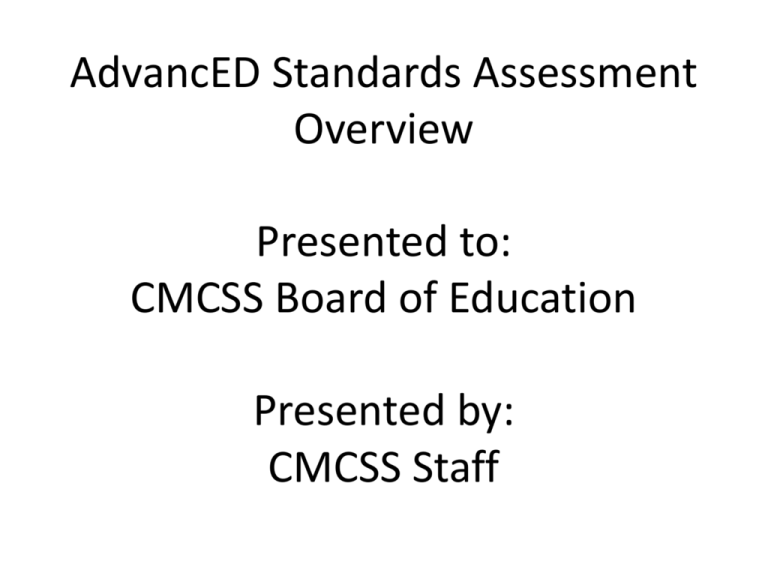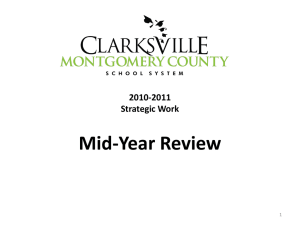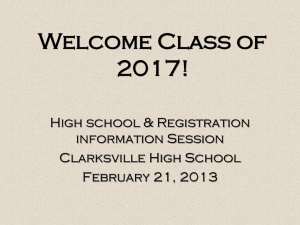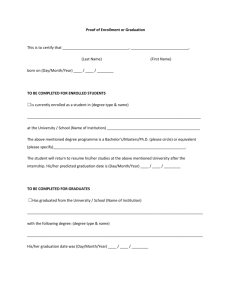Monthly Board Reports Annual Key Performance Indicators
advertisement

AdvancED Standards Assessment Overview Presented to: CMCSS Board of Education Presented by: CMCSS Staff Vision and Purpose Vision and Purpose • Mission Statement – Our Mission is to educate and empower our students to reach their potential. • Vision – Each student will graduate from high school career or college ready. • Strategic work is aligned with key performance indicators and budget development. Deciding on the Strategic Work to Support the Vision • Board of Education Ends Policies – Student Data – Monthly School Visits with Focus Questions on the School’s and the District’s Work – Mid-Year and End-of-Year Reviews – Principal Academic Conferences – Monthly Stakeholder Communication Group Feedback Monitoring the Strategic Work in Support of the Vision • Board of Education Ends Policies – Student Data – Monthly School Visits with Focus Questions on the School’s and the District’s Work – Mid-Year and End-of-Year Reviews – Principal Academic Conferences – Monthly Stakeholder Communication Group Feedback – Monthly Board Reports – Annual Key Performance Indicators Current District Profile • Approximately 30,500 Students – White- 58%, African American- 28%, Hispanic- 10% Asian/Pacific Islander, Native American, Alaskan- 4% – Free and Reduced Lunch- 49% – English Language Learner- 3% – Military- 27% – Mobility- 35% – Special Education- 15% • 36 Schools- 21 Elementary Schools, 7 Middle Schools, 7 High Schools, and a Middle College • Growth- 2% Annually – One Elementary School Opening Fall 2012 – One Elementary School Opening Fall 2013 Changes Impacting Student Achievement Measures • More Rigorous Standards • More Rigorous Assessments Were Implemented • Redefined Proficiency Levels • Recalibration Using 2009 as a Baseline Report Card 2010-2011 Academic Year What Do the Grades Mean? 3rd–8th Grades • Letter grade “A” or “B” indicates the students in the school performed above the identified target. • Letter grade of “C” indicates the students in the school performed at the expected target. • Letter grade of “D” or “F” indicates the students school did not meet the expected target. What Do the Grades Mean? (Cont.) High School • High Schools do not receive letter grades; they receive status grades. • The status grade is based on the students’ predicted achievement and expected growth developed from prior performance on state assessments. CMCSS Report Card Achievement 2009-10 CMCSS Report Card Achievement 2010 - 11 2009-10 Achievement 2010-11 Achievement Rdg Math Sci SS B B A A Percent of Schools equaling or exceeding achievement standards (C,B, or A) 96% 93% 100% 96% Percent of Schools exceeding achievement standards (B or A) 75% 75% 93% 96% CMCSS Rdg Math Sci SS B B A A Percent of Schools equaling or exceeding achievement standards (C,B, or A) 96% 93% 100% 100% Percent of Schools exceeding achievement standards (B or A) 71% 71% 93% 100% CMCSS CMCSS Report Card Value Added 2009-10 CMCSS Report Card Value Added 2010 - 11 2009-10 TVAAS 2010 -11 TVAAS Rdg C Math C Sci B SS C Percent of Schools equaling or exceeding expected growth (C,B, or A) 14% 29% 46% 89% Percent of Schools exceeding expected growth (B or A) 11% 4% 21% 61% CMCSS Source: CMCSS 2009-10 State Report Card: 2010 EVAAS Site Rdg C Math C Sci D SS Percent of Schools equaling or exceeding expected growth (C,B, or A) 58% 58% 50% 81% Percent of Schools exceeding expected growth (B or A) 27% 27% 38% 77% CMCSS Source: CMCSS 2010 - 11 State Report Card: 2011 EVAAS Site Created 11.4.2011 Sucharski.Tomes B Value Added 201011 System Math Reading Social Studies Grad Economically Student Science Rate Disadvantaged ADM 201011 Memphis C F C D 72.6 84.6% 102,798 Davidson C D C D 76.2 75.0% 73,117 Knox B C B C 86.6 45.8% 54,486 Shelby C D C D 88.9 38.3% 46,249 Hamilton C D B D 81.7 60.8% 40,985 Rutherford B B B C 91.5 43.6% 36,730 Williamson C B B D 91.8 12.2% 30,988 CMCSS C C B D 93.5 48.5% 28,580 Sumner D D C F 89.6 41.0% 27,031 Wilson C C B D 90.3 28.7% 15,139 Sevier C C C F 80.3 64.1% 14,108 Madison D D D F 91.6 80.2% 12,553 Tipton A C C D 96.5 58.5% 11,639 Maury D C C C 81.9 59.3% 11,183 Sullivan D D C D 90.7 54.7% 10,888 Blount A C B D 90.0 53.6% 10,917 Key to TN Report Card Grades Achievement Value Added A = Exemplary A = Exceptional B = Above Average B = Exceeds Expected Growth C = Average C = Met Growth Expectation Achievement 201011 System Math Reading Social Studies Science Grad Rate Economically Disadvantaged Student ADM 201011 Memphis D F F F 72.6 84.6% 102,798 Davidson C D C D 76.2 75.0% 73,117 Knox B B B B 86.6 45.8% 54,486 Shelby A A A A 88.9 38.3% 46,249 Hamilton B C B C 81.7 60.8% 40,985 Rutherford A A A A 91.5 43.6% 36,730 Williamson A A A A 91.8 12.2% 30,988 CMCSS B B A A 93.5 48.5% 28,580 Sumner B B A B 89.6 41.0% 27,031 Wilson B B A A 90.3 28.7% 15,139 Sevier C C B B 80.3 64.1% 14,108 Madison D D D D 91.6 80.2% 12,553 Tipton B B B B 96.5 58.5% 11,639 Maury C C C C 81.9 59.3% 11,183 Sullivan B B B B 90.7 54.7% 10,888 Blount B C B B 90.0 53.6% 10,917 Key to TN Report Card Grades Achievement Value Added A = Exemplary A = Exceptional B = Above Average B = Exceeds Expected Growth C = Average C = Met Growth Expectation D = Below Average D = Below Growth Expectation F = Deficient F = Deficient 9 - 12th Value Added for EOC and Gateway Assessments Status Status Subject 20091 201011 Math (ALG I) Above Above Science (Biology I) NDD Below English (ENG II) NDD Below English I Below Below US History NDD Below 3 yr avg ALG II will be released after summer standard setting, ENG III was field tested in 201011 Source: 201011 EVAAS ACT 2010-11 for Graduating Seniors Subject Obser. Score Pred. Score Status 3 yr avg Pred 3 yr avg Status 3yr Composite 19.35 19.29 NDD 19.78 19.53 Above English 18.94 19.08 NDD 19.3 19.32 NDD Math 18.85 18.56 Above 19.1 18.81 Above Reading 19.60 19.74 NDD 20.23 19.97 Above Science/Reasoning 19.51 19.27 - 19.93 19.53 - Source: 201011 Report Card Created: 11.11.2011 Sucharski.Tomes CMCSS AYP Graduation Targets and Actual Graduation Rates FINAL School Year 2003-04 2004-05 2005-06 2006-07 2007-08 2008-09 2009-10 2010-11 2011-12 2012-13 2013-14 District AYP 75.9% 77.2% 78.6% 80.0% 81.3% 82.7% 84.0% 85.4% 86.8% 88.1% 100% Graduation Target District Actual 76.0% 76.2% 78.5% 85.70% 88.33% 90.78% 91.0% 92.1% 93.5% Graduation Rate Year included in AYP Calculations 2005 2006 2007 2008 2009 2010 2011 2012 2013 NOTE:Graduation rate data is released as part of the following year's AYP calculations. Created 9.1.2011 Sucharski.Tomes Source: CMCSS AYP Graduation Data 2014 2015 Trends • Math has improved. • Writing has improved. • Reading/Language Arts has been on a decline especially in the secondary schools. • Special needs achievement has improved but not at the rate needed to reach proficiency targets. • Graduation rates are improving. Strengths • • • • • Math Writing Graduation Rate Professional Development Leadership Training Challenges • Meeting Proficiency with All Students, Especially Special Needs, ELL, and ED • Transitioning to Common Core • Transitioning in Accountability Measures • Hiring and Retaining Quality Teachers, Especially in Math, Science, Career Technical Education, and Special Education Governance and Leadership Clarity of Roles and Responsibilities • • • • • Policy Governance Board of Education Ends Policies District Strategic Work Senior Leadership Team CMCSS Organization Chart Board and District Leads, Directs, Supports, and Allocates Resources • Policy Governance • Board of Education Ends Policies • Senior Leadership Team • Strategic Planning Cycle • Performance Based Budgeting • Administrative Action Plans • Monthly Board Reports • Mid-Year and End-of-Year Reviews • Program Monitoring and Audits • Professional Development • Continuous Improvement System – Management Review Team – Internal and External Audits Equity of Learning and Innovation • Innovations – – – – – – – – – Strategic Planning Cycle 100% Graduation Project STEM Integration STEM Academy Virtual Classes and Virtual School Pilot Middle College@APSU Career-Technical Education Model Classrooms Technology Access for Teachers and Students • Innovations (Cont.) – – – – – – – District Grant Writing Leadership Development Just-in-Time Training Classified Staff Training ISO 9001 Certification School Zoning Student Code of Conduct Equity of Learning and Innovation (Cont.) • Intervention Programs – Math and Reading Targeted Interventions – Individualized Education Plans – Dual Enrollment – ACT Preparation Classes – Advanced Placement Classes – Gifted Services (PASS) – After School Programs • Intervention Programs – – – – – – Credit Recovery ELL Title I Virtual Classes Virtual School Pilot Pre-Kindergarten Board Training • • • • • Annual Board Retreat TSBA Meetings School Board Academies Consultants to Train and Advise Senior Leadership Study Sessions Based on Strategic Work • Updates from Director and Senior Leadership on Current Legislation Teaching and Learning How Curriculum is Selected • Research from National Standards • National and State Subject Area Associations • Integration of Common Core Standards • Knowledge of Experienced Teachers • Curriculum Consulting Teachers • Equity and Diversity in Teacher Committee Selection How Teachers are Supported • Academic Coaches, Curriculum Consulting Teachers, Technology Integration Coaches, and Mentors • Ongoing Professional Development • Professional Learning Communities • Leadership Academies • New Teacher Induction Process • Benchmarks and Data Chats to Drive Instruction • Scope and Sequence • TestDrive, Curriculum Navigator, and PowerSchool • TEAM • Intervention Protocols • Model Classrooms • Community Involvement How Students are Provided Opportunities to Learn • 100% Graduation – – – – – – – – – – – Explicit instruction STEM Integration STEM Academy Balanced Assessment Differentiated Instruction Rigor and Relevance Benchmarks and Progress Monitoring Scope and Sequence Career-Technical Education Model Classrooms Mobile Computer Stations and Fixed Labs • Interventions – Math and Reading Targeted Interventions – Individualized Education Plans – Dual Enrollment – Advanced Placement Classes – Gifted Services (PASS) – After School Programs – Credit Recovery – English Language Learners – Title I – Virtual Classes – Virtual School Pilot – Pre-Kindergarten Documenting and Using Results Comprehensive Assessment System • Aligned to the Identified Standards and Expectations of Performance Targets Focused on Student Performance at the Following Levels: — — — — — Classroom Building District State National Comprehensive Assessment System • Quantitative and Qualitative Measures, Including but not Limited to • Classroom, Building, District Assessments —Common Assessments —Program Measures (READ Well, Language!, READ 180, Modified Math, etc.) —Benchmarks, Learning Links (Pilot) —Brigance —DIBELS (Dynamic Indicators of Basic Early Literacy Skills) NEXT —Non-Academic Indicators (Attendance, Discipline, Graduation, etc.) • State Assessment —TCAP Achievement, TCAP End of Course, TCAP Constructed Response —TCAP Writing, TCAP ALT Portfolio —Tennessee English Language Placement Assessment and English Language Development Assessment • National Assessments —ACT, Advanced Placement (AP), PSAT Comprehensive Assessment System • Timely, Accurate, and Meaningful Data —Collected and Disseminated Within Hours of Completion (Benchmarks, Learning Links, etc.) or Within 5–7 Days of District’s Receipt of Data (TCAP, ACT, Report Card, etc.) —Provides Insight to Student Performance in Terms of Identified Standards and Levels of Proficiency (Standards Proficiency, RCPI, Achievement, Value Added, etc.) —Includes Qualitative and Quantitative Data Points —Disaggregated by Subgroups and Programs (Interventions, Afterschool, etc.) —Identifies Academic Growth experienced —Used to Evaluate Student Performance in Terms of Current Results and Three - Five Year Trends Resource and Support Systems Employment and Assignment of Well-qualified Staff • Hire Right • Capitalize on Current Employees’ Success • Systematically Review Job Descriptions and Requirements • Monitor Employee Performance and Development Needs Provision of Ongoing Learning Opportunities to All Staff • • • • Initial Training Recurring Training Just-in-Time Trainings On-going Needs Assessments Effectiveness of District Learning Opportunities • Professional Learning Activities Network (PLAN) – – – – – Course Development Enrollment and Attendance Class Evaluations Monitoring and Reporting Pre- and Post-session Communications • Evaluation — Initial Evaluation Immediately After Training — Implementation or Learning Evaluation (Identified Through Observations, Evaluations, Data Analysis, Academic Conferencing, Mid-Year and End-of-Year Reviews) — Job-embedded (Application of Knowledge and Skills) Budgetary Planning for Sufficient Financial Resources • Strategic Work Plans Driven by the Board of Education Ends Policies • Mid-Year and End-of-Year Reviews and Stakeholder Input • Performance Based Budgeting and Key Performance Indicators Align Financial Resources to Desired Outcomes • Transparent Process, Communicated to All Stakeholders Maintain Safe, Orderly, and Healthy Environment • • • • • Employee Handbook Student Code of Conduct Emergency Management and Crisis Planning Safety and Security Programs and School Committees Environmental Management and Hazardous Materials Programs • Student Health Services – Individual Health Planning, Immunization Compliance and Accident Reporting • Student Wellness – Wellness Programs, School Counseling and Bullying Awareness and Prevention • Employee OJI Program – On-site Health Care, Safety Training, Monthly Safety Newsletter, and Accident Investigation Sufficiency of Technology Infrastructure to Meet Goals • Laptop for Every Teacher • 1 to 1 Computer to Student Ratio (4TH & 5TH Grades Moore Magnet & STEM Academy) • Model Classroom Implementation • Mobile Computer Stations and Fixed Labs • Support for Specific Programs —STEM Academy —Vernier Probes —TI Inspires —Career Technical Education Program Specific Equipment Sufficiency of Technology Infrastructure to Meet Goals • Direct Support for Technology Infrastructure — — — — — — On-going Technology Training Work Order System Computer First Aid Station Well-communicated Policies and Procedures Technology Disaster Recovery Plan Technology Integration Coaches Sufficiency of Support Services to Meet All Students’ Learning Needs • Support Services for Students with Disabilities, Economically Disadvantaged Students, and ELL Students • School Support Teams Identify Student Needs and Coordinate Appropriate Interventions and Services • Department Chiefs, Directors, Program Coordinators, and Special Education Consulting Teachers Monitor Interventions for At-risk and Identified students • Individual Education Plans for Students with Qualifying Disabilities Whose Needs Cannot be Met in the General Education Classroom • 504 Plans for Modifications and Accommodations for Students with Qualified disabilities • Health Plans for Any Student with Medical Needs Stakeholder Communications and Relationships Community Stakeholders • • • • • • • • • • District Website and Feedback Community Consortium Media Education Foundation Partners in Education District Survey and Focused Surveys 100% Graduation Committee Leadership Clarksville Education Day Leadership CMCSS Presence and Involvement in Community Activities Parent Stakeholders • • • • • • • • Parent Communications Group Meetings District Survey and Focused Surveys PowerSchool School Handbooks Parent-Teacher Conferences School Open Houses School Messenger Report Cards Employee Stakeholders • Teacher Stakeholder Questions and Group Meetings • Employee Anchor Team • Classified Representatives Meeting • Continuous Improvement System • Management Review Team • District Survey and Focused Surveys • Teaching, Empowering, Leading, and Learning (TELL) Tennessee Survey Commitment to Continuous Improvement CMCSS Strategic Planning Cycle • • • • • • • • • Board of Education Ends Policies Data Gathering Monthly Stakeholder Communication Groups District Survey and Focused Surveys Strategic Work Plan Performance Based Budgeting District Action Plans Principal Action Plans Monthly School Visits, Principal Meetings, and Professional Learning Communities • Mid-Year and End-of-Year Reviews • Academic Conferences Continuous Improvement Continuous Improvement System • ISO 9001:2008 is an internationally recognized standard for a quality management system that: —Consistently meets customer and regulatory requirements —Continuously improves stakeholder satisfaction • The Quality Policy for the Central Office of CMCSS is to provide Business Affairs, Communications, Human Resources, Instruction, Operations, and Technology support for our schools in achieving the district’s mission which is: To Educate and Empower Our Students to Reach Their Potential. Continuous Improvement • Quality Principles – Customer-Focused Organization – Leadership – Involvement of People – Process Approach – System Approach to Management – Factual Approach to Decision Making – Mutually Beneficial Supplier Relationship Quality Assurance Methods Quality Assurance • Strategic Planning Cycle —Mid-Year Review —End-of-Year Review • Continuous Improvement System (ISO 9001) —External Certification Audits —Internal Audits —Mid-Year Review —End-of-Year Review





